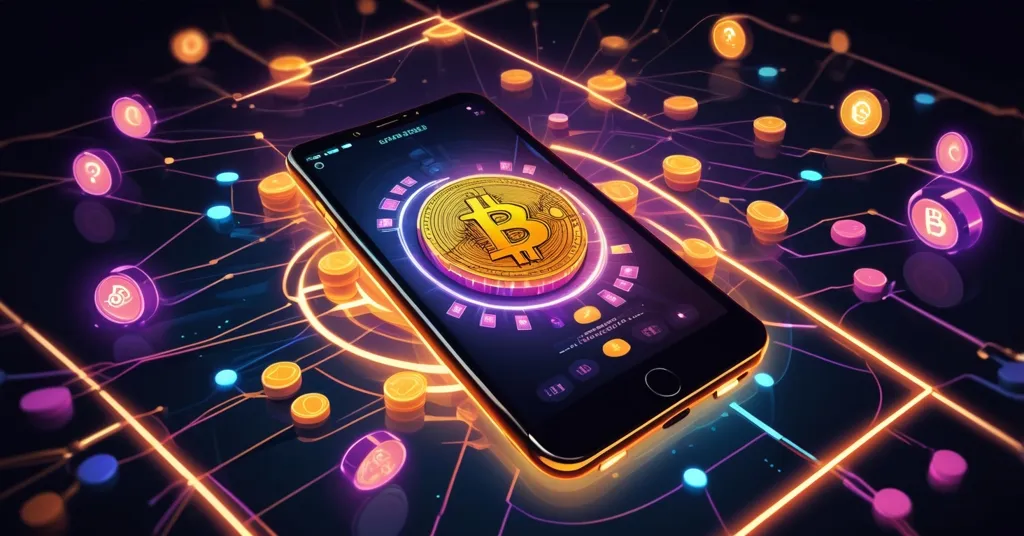Bitcoin Solaris: Next Ethereum or Overhyped Altcoin Scam? A Deep Dive into Presale Hype

Bitcoin Solaris: The Next Ethereum or Just Another Hype Train?
Bitcoin Solaris (BTC-S) has burst into the crypto spotlight, riding a wave of presale success with over $5 million raised and a bold claim to outshine Ethereum’s historic 92,000% price surge. But beneath the glitter of mobile mining apps and live casinos, is this altcoin a genuine disruptor or just another project banking on investor FOMO?
- Presale Momentum: Token price climbed from $5 to $8, with over 11,500 investors and $5 million raised.
- Utility Claims: Features mobile mining via the Solaris Nova App, a live Bitcoin Solaris Casino, and a planned Mining Power Marketplace.
- Ethereum Comparison: Touted to surpass Ethereum’s massive growth, though the “expert agreement” reeks of marketing spin.
Presale Snapshot: Numbers That Turn Heads
Bitcoin Solaris is still in its presale phase—Phase 8, to be exact—with the token price jumping from $5 to $8 and a reported $5 million-plus raised from over 11,500 investors. The next phase is set at $9, with a launch price of $20 and an 8% bonus dangled for early birds. The project boasts a fixed supply of 21 million tokens, a deliberate nod to Bitcoin’s scarcity model, with just 4.2 million available in the presale. No emissions, no delayed unlocks—just a neat, predictable tokenomics pitch. On the surface, it’s a sizzling opportunity for those chasing the next big crypto moonshot, especially with presale performance updates showing strong investor interest. But let’s not get starry-eyed yet. Presales are the Wild West of crypto, where dazzling numbers often mask shaky foundations. We’ve seen countless projects spike during presale only to vanish into thin air. So, while the stats grab attention, they’re just the first chapter of a much longer, riskier story.
Mobile Mining: Democratization or Gimmick?
One of Bitcoin Solaris’ flagship features is the Solaris Nova App, which claims to let users mine tokens using idle smartphone storage and CPU power. Forget expensive ASIC rigs—specialized hardware that can cost thousands and guzzle electricity like a Hummer. This app aims to democratize mining, the process of validating blockchain transactions by solving complex problems, by turning your phone into a mini-rig. Reportedly, beta testers are seeing returns that outpace many staking platforms, and the app boasts a wild 99.95% energy efficiency advantage over Bitcoin’s power-hungry mining model, as highlighted in discussions about mobile mining technology. If true, this could be a game-changer, especially in regions where smartphones are everywhere but high-end hardware isn’t. Imagine earning crypto while scrolling memes—sounds like a dream, right?
But here’s the flip side: untested tech in crypto often overpromises and underdelivers. There’s no hard data on beta user experiences, no verified metrics on returns, and no clarity on how this scales without draining your phone’s battery or data plan. Could this be a genuine push for accessibility, or just a shiny gimmick to lure in non-tech-savvy investors? Without transparency, it’s a coin toss—and in crypto, you don’t want to bet on heads or tails without seeing the coin.
Bitcoin Solaris Casino: Gamification or Regulatory Trap?
Already live, the Bitcoin Solaris Casino is another hook, blending crypto with gambling through daily free spins and reward tiers tied to token purchases. Drop $2,500 in BTC-S, and you might snag a draw for up to 0.5 BTC. It’s a classic gamification tactic—make holding tokens “fun” to keep users engaged. This isn’t new; other platforms have used similar strategies to boost adoption, and recent updates on the casino show ongoing development. But gambling and crypto are a spicy mix, especially as regulators worldwide tighten the screws. Governments are cracking down on such pairings over concerns like money laundering and consumer protection—look at recent bans on crypto gambling in places like the UK. Could this casino be an innovative way to drive token utility, or is it a ticking time bomb for legal heat? BTC-S might attract thrill-seekers, but it could also attract the kind of scrutiny that sinks projects overnight.
Mining Power Marketplace: Visionary or Vague?
Still in development, the Mining Power Marketplace promises to let users rent out excess compute power on-chain. Think of it as an Airbnb for processing power—potentially useful for things like AI training, gaming, or other decentralized compute needs. It’s a neat concept, aligning with the trend of monetizing unused resources in a decentralized way, something we cheer for as champions of effective accelerationism. If executed well, it could carve a niche that complements Bitcoin’s store-of-value focus by adding practical utility to the ecosystem. But right now, it’s just a roadmap item with scant details. What are the real use cases? How secure is the system? Without meat on these bones, it’s hard to see this as anything more than a buzzword-heavy promise. Crypto roadmaps are notorious for hype over substance, and this feature needs proving before it’s worth applauding.
Hype vs. Reality: Can It Really Beat Ethereum’s 92,000% Surge?
Bitcoin Solaris is being positioned as the next Ethereum, with claims it could outpace the latter’s staggering 92,000% growth from under $1 to over $4,000. Ethereum’s rise was fueled by groundbreaking smart contracts—self-executing digital agreements—that birthed an entire ecosystem of decentralized apps and developer innovation over years. BTC-S, by contrast, leans on mobile mining and accessibility as its big draws. Reviews from outlets like Crypto Infinity and Crypto Show call it “innovative” and “the most balanced ecosystem of 2025,” but let’s be real—these sound like paid promos, not hard analysis. The press release pushing these claims, such as those covered in predictions about Bitcoin Solaris growth, even carries a disclaimer noting it’s a paid post, with no guarantee of accuracy. That’s a red flag bigger than a bull in a china shop.
Comparing a presale project to a blockchain giant is a tired altcoin marketing trick. Ethereum’s early days were messy and slow, but it built a foundation. Bitcoin Solaris is promising the moon before even hitting its $20 launch price. Could it grow significantly? Maybe, if mobile mining catches fire and adoption soars. But 92,000%? That’s a number so absurd it might as well be scribbled in comic sans. Grounded projections based on presale traction or app downloads would be more credible, but those are nowhere to be found. This narrative smells of snake oil, and investors should sniff twice before buying in.
Trust and Transparency: Audits, KYC, and Paid Hype
On the credibility front, Bitcoin Solaris isn’t entirely in the dark. Its infrastructure has been audited by Freshcoins and Cyberscope, firms that add a layer of reassurance in a space rife with scams. The development team has also completed KYC—Know Your Customer—verification, a step toward transparency when anonymity often shields fraudsters. But let’s not hand out gold stars yet. The reputation of these auditors isn’t ironclad; some firms have endorsed projects that later flopped or scammed. And while KYC is a plus, it doesn’t guarantee long-term integrity. Media praise from channels like Crypto Vlog highlights BTC-S for delivering during presale, not just promising future fluff. Yet, the paid nature of press releases—explicitly disclaimed on platforms like WJBF—casts a shadow. Hype bought with cash isn’t the same as organic trust earned through results. For more background on the project, resources like the Bitcoin Solaris wiki can provide additional context. Proceed with caution; audits are a start, not a safety net.
Risks and Market Context: A Cautionary Tale
Presale investments are a gamble, and Bitcoin Solaris is no exception. Crypto history is littered with projects like Bitconnect, which hyped massive returns in 2017 only to collapse as a Ponzi scheme, leaving investors gutted. BTC-S’s presale success and utility promises are enticing, but the lack of long-term proof—combined with paid promotions—screams risk. Mobile mining at scale is untested, the casino could draw regulatory wrath, and roadmap items like the Marketplace might never materialize. In 2025’s altcoin frenzy, where mobile-first solutions and liquid staking are trending, BTC-S fits a popular niche. But trends don’t equal sustainability. Many projects chasing accessibility have floundered when tech or adoption didn’t pan out. Even with audits, rug pulls and broken promises remain rampant in this space. If you’re curious about community sentiment, check out user feedback on the Solaris Nova App. If you’re eyeing BTC-S, remember: early-stage crypto is a high-stakes poker game, and the house often wins.
Bitcoin Maximalist Lens: A Niche Worth Watching?
As a Bitcoin maximalist, I’ll always root for the king of decentralization, built on security and store-of-value principles. Bitcoin isn’t designed for every use case—its laser focus leaves gaps for altcoins to experiment. Bitcoin Solaris, with its mobile mining push, could theoretically onboard millions to crypto, especially in underserved regions. That’s a win for broader adoption and the ethos of freedom and privacy we stand for. But I’m wary of app-based models centralizing control with developers instead of truly decentralizing power. What if BTC-S succeeds wildly and reshapes access to mining? It might challenge Bitcoin’s dominance in narrative, if not function, while driving the industry toward inclusivity. For those weighing investment potential, platforms like Quora discussions on BTC-S offer varied perspectives. Still, Bitcoin’s proven resilience trumps untested promises. Altcoins like BTC-S deserve a glance for carving niches, but they’re sidekicks, not the main act, in this financial revolution.
Key Takeaways and Questions on Bitcoin Solaris
- What is Bitcoin Solaris (BTC-S) and its core pitch?
It’s a new altcoin in presale, raising over $5 million, focused on mobile mining via the Solaris Nova App, a live casino, and a planned Mining Power Marketplace, promising high growth potential. - Can Bitcoin Solaris match Ethereum’s 92,000% growth?
Highly unlikely; the claim lacks credible expert backing or data, and Ethereum’s success stemmed from years of ecosystem building, unlike BTC-S’s unproven presale hype. - What makes mobile mining via Solaris Nova App unique?
It allows mining using smartphone resources, bypassing expensive hardware, aiming for accessibility, though its scalability and real returns remain unverified and risky. - How risky is investing in Bitcoin Solaris during presale?
Extremely risky; presales often fail or turn into scams, and despite audits and KYC, paid promotions and untested features like the casino add significant uncertainty. - Does the Bitcoin Solaris Casino pose regulatory challenges?
Yes, tying rewards to token purchases could attract scrutiny for money laundering or consumer protection issues, as seen with other crypto gambling platforms facing bans. - Should Bitcoin maximalists pay attention to BTC-S?
To a degree; while Bitcoin reigns for security, BTC-S’s accessibility push could complement the ecosystem by onboarding new users, though it’s no substitute for BTC’s core value.
Bitcoin Solaris dangles some intriguing ideas—mobile mining to lower entry barriers, a live casino for engagement, and a marketplace for decentralized compute power. Its presale traction shows investor interest, and audits offer a baseline of trust. But the Ethereum growth comparison is speculative nonsense, and the risks of unproven tech and regulatory pitfalls loom large. I’m all for projects pushing decentralization forward, but in crypto, hype is cheap. Dig deeper, question harder, and don’t let shiny promises cloud your judgment before you stack sats or altcoins.



